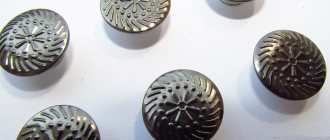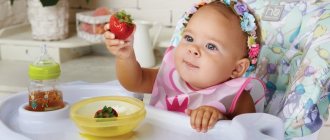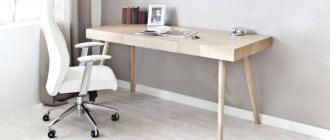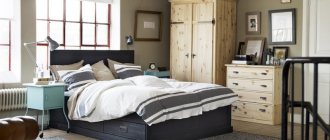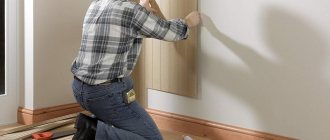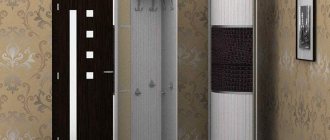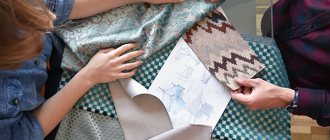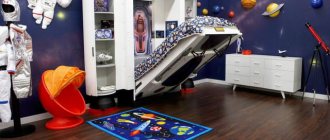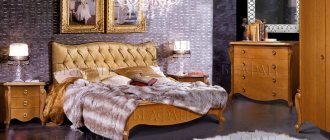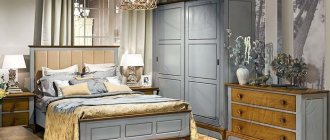Types of furniture fittings
The cabinet, drawers, shelves are assembled using fasteners, which differ in size, material of manufacture, installation method and features of use. They are divided into several types.
- Front fittings for cabinets include parts that are located on the front facade of the product and, in addition to operational functions, serve as decorative elements.
- Fasteners are used to assemble furniture panels into a single frame.
- Additional products for the internal equipment of wardrobes are parts for installing shelves, rods in wardrobes, mounting mirrors, hangers.
Description
The fittings
have a wide classification. It can be furniture (handles, hinges, plugs), shoe (zippers, buckles, laces), construction (locks, connectors, closers), windows (handles, hinges), etc. The process of manufacturing accessories, as a rule, is separate. from the production of the main components of the product. This is due to the fact that its manufacture requires a completely different technical process.
Furniture fittings
allows you to diversify and make your furniture look completely unique. Wardrobes, bedside tables, kitchen and cabinet furniture, commercial equipment - the main differences from similar products lie, first of all, in the design of the furniture fittings used.
Fasteners
The service life of furniture depends on the quality of fasteners. They ensure its stability, increase its ability to withstand heavy weight and help avoid distortions of the door leaves.
Furniture hinges are used to secure the door to the furniture body. Their task is to open the door at 900 and keep it suspended. For this purpose, four-hinged overhead and semi-overlay hinges are used. They are attached using self-tapping screws to the facade panel and drawer.The cabinet door is located on the surface of the facade and is locked onto the end of the cabinet. Internal hinges allow the door to fit inside the cabinet body. A continuous facade surface without protruding edges is formed.
Corner hinges are used when installing doors with an opening angle of up to 1750. A piano hinge is used to fasten wide wardrobe doors. Made in the form of two hinged plates. It is installed over the entire height of the doors and secured with self-tapping screws.
We recommend reading:
White cabinet - instructions on how to combine it in a modern interior. 120 photos of new products with beautiful design and placement!
Wenge-colored wardrobe in a modern interior: 100 photos of beautiful design and proper placement
- Pull-out cabinet: description of all types according to method of use. Examples of placement in a modern interior (120 photos)
For fastening the furniture body, confirmat, eccentric coupler, corners, and dowels are used. They are used for fastening parts of the body, back wall, partitions. Due to their design features, they are used for installation of wood, plywood, plastic, MDF, chipboard and fiberboard.
Door hinges
Hinges are presented in a wider variety of species - they are classified according to the type of fastening:
- overhead – standard models, attached completely to the ends of the furniture walls;
- semi-overhead – mounted only on half of each end;
- corner – mounted at an angle from 30 to 180 degrees;
- internal - hidden products for internal fixation of doors in furniture niches.
When selecting hinges, you need to carefully study the quality, check how well they fit in the grooves. The components must be highly durable and silent during operation.
Additional accessories
To ensure maximum comfort and ease of use of cabinets, automatic closers are installed on the doors. These are components for cabinets with the help of which the door closes smoothly and silently. Installed on horizontally and vertically opening doors. Their use extends the service life of hinges and protects the surface of the facade from chipping and cracking.
Corners are used to install and secure shelves inside the cabinet. They are made of metal, aluminum or plastic.
Shelf holders are stamped from metal wire with a diameter of up to 1.5 cm with a characteristic protruding bridge in the center of the part. A type of rod holder is a blade-shaped holder. Fixing plastic and metal ones are made in the shape of a corner, with a thickening of the load-bearing part. The wide working surface of the product ensures reliable fixation under heavy loads.
For retractable shelves and cabinet drawers, two modifications of guides are used: roller and ball.
The cabinets are equipped with legs and thrust bearings, which are covered with a removable base. Also installed inside are rods for clothes, wire structures for small accessories, and hooks for bags.
Small nails, screws, self-tapping screws, screws with washers and sealant are used as small fasteners.
Fasteners
Any furniture, be it a kitchen set, a wardrobe, a chair or a sofa, is inherently separate parts fastened together. For reliable fixation, fasteners are needed. The fastener must meet several important requirements:
- Connection reliability
- Hidden installation
- Accessibility for adjustment
Fasteners are one of the most important elements of high-quality furniture, since reliability is hidden in the details. You need not only good fasteners, but also correctly selected fasteners for a particular structural element.
Types of fasteners
Each specific furniture unit requires its own type of fastener; the point is that it will not be possible to assemble a kitchen set using only self-tapping screws. Even if it works, it will either not be reliable, or not beautiful, or both. Proper fastening is the key to ensuring that the furniture will last for many years.
There are several typical fasteners, such as:
- Corners
- Confirmations
- Self-tapping screws
- Bolt nut
- Shelf supports
- Dowels
- Intersectional couplers
- Corner couplers
It is worth mentioning each type of fastener separately.
- Corners. Corners are one of the most common and simplest devices for fixing two planes to each other. Usually made of plastic, steel or aluminum. They have several holes in each plane. The holes are often cone-shaped for hidden installation of self-tapping screws. Sometimes they have stiffening ribs for greater reliability.
- Confirmations. Confirmat can be called the best invention in the field of fastening furniture elements. It has a huge number of advantages over conventional self-tapping screws. It has a large thread with a large pitch, can withstand heavy fracture loads, and is very convenient to fasten with a hexagon, so the mounting slots will be in order.
- It has another common name - euro screw. To use a confirmat, you will need a special two-step drill, or you can use a separate 5 mm drill for the body of the screw and an 8 mm drill for the screw head.
- Self-tapping screws. Self-tapping screws are the most common and simple fastener; they are usually used for fastening corners.
- Bolt nut. This is the most uncompromising and reliable type of fastener, although not the most elegant. The bolt head can be a standard turnkey type, or it can be a decorative rounded one, in which case it is secured by an inner square on one side and a nut on the other.
- Shelf supports. Shelf holders are elements made of metal or plastic, the main task of which is to be a support for various kinds of shelves made of glass or chipboard
- Dowels. A dowel is a wooden cylinder, 35x8 mm in size, for hidden fastening. To use dowels, it is enough to make holes with a diameter of 8 millimeters in two planes that need to be connected, and insert the dowel into them. To increase the strength and durability of the connection, you can use PVA glue.
- Intersectional couplers. They are a decorative version of the nut-bolt fastener. Used for fastening kitchen cabinets.
- Angular or eccentric couplers. Used for hidden installation. It is very convenient to attach perpendicular planes. The difficulty is that it is very difficult to calculate the holes for this fastener.
There are some other types of fasteners, but these are the most common and are found in 99% of cases.
Accessories for wardrobes
Thanks to its spaciousness, convenience and ability to fit into any interior, the sliding wardrobe has taken a leading place in the furniture industry. It is structurally different from conventional wardrobes and its assembly requires special fittings.
Rollers, asymmetrical or symmetrical, move the door without any effort. Made from plastic, steel with rubber or Teflon coating. The wardrobe roller located below takes on the weight of the door.
The fittings for a sliding wardrobe include upper hinged and lower support panels. Profiles are produced from plastic, aluminum and metal alloy. To fix the door in a vertical position, door guides are mounted on the upper profile - runners in which the rollers move.
To ensure silent sliding of the rollers along the profile, a seal is used, which is made from materials that can dampen noise and ensure smooth, smooth sliding.Silicone and universal seals are reliable, durable and environmentally friendly materials. To protect the interior of the cabinet from dust, a brush seal is used.
The profile serves as the basis for the door leaf; a wood board is mounted on it. The type of profile determines the material from which it is made - steel or aluminum.
The stopper blocks the door and fixes it in a certain position. It is made of durable steel and mounted on the lower guide profile.
All components of furniture fittings are made from high-quality, durable materials. They ensure the service life of the structure, its durability and reliability. Thanks to small fasteners, the product gains stability, strength, fits into the interior and pleases the owners.
Handles for doors and drawers
One of the most frequently requested elements are furniture handles for doors and drawers. These products must have a sufficient margin of safety and be covered with a protective layer. In addition, components should be securely fastened, since constant mechanical load can quickly lead to their failure. Regarding the material of manufacture, the choice is yours.
The most common are metal handles. Less common are plastic products. Its advantage is the absence of corrosive processes. A disadvantage can be considered the risk of deformation, especially in conditions of elevated room temperature. Porcelain components are particularly elegant. They fit perfectly with many interesting stylistic solutions.
Photos of cabinet fittings
Assembly using fasteners
Which set is included with the cabinet depends on the type of cabinet and its design. Bolts are used where necessary. If necessary, wood veneers are hammered. Each disassembled cabinet from the store is given an assembly diagram.
By carefully reading the instructions and following the assembly diagram, you can assemble the cabinet yourself on site, in your apartment. If the cabinet is unfamiliar, something that a person has never assembled, you need to carefully delve into the diagram. Take your time when assembling.
Otherwise, you can ruin the accessories, which are in limited quantities. In addition, you can lose time during assembly. It's better not to rush. It must be done thoroughly. This is the right path to success. You also need to have good assembly tools on hand.
Kitchen sinks
Design options for kitchen sinks are shown in Figure 23, and the connection of kitchen sinks to the countertop is shown in Figure 24.
Rice. 23. Kitchen sink options
Rice. 24. Option for connecting a kitchen sink to a countertop
Bed ties
Used to connect the backs and sides of the bed (Fig. 1–5).
Rice. 1. Screw bed tie
Rice. 2. Hook bed tie
Rice. 3. Trapezoidal screed
Rice. 4. Middle bed tie (trapezoidal)
Rice. 5. Connection to a bed tie
Correct door hanging
Different models have different ways of constructing door reinforcements. Some require door guides. Which must be secured to the cabinet in advance before putting the doors on. These wardrobes have sliding doors.
It is better to fasten the guides in this way. Mark the locations with a marker. There will be screws there. Then use a thin drill to drill a little in these places. And attach the guides to the screws.
Do-it-yourself upholstery of upholstered furniture: step-by-step master class, advantages and disadvantages of updating furniture (130 photos)Wardrobe for the bedroom: the best models of 2022 and modern solutions from leading manufacturers (120 photos and videos)
Shelves for the bedroom - modern ideas for use and current combinations with interior design (125 photos and videos)
To be sure, you must first secure the front, middle, and end of the guides. Then the rest. Typically, two sliding doors have two guides, to the right and left of the cabinet.
Build steps
It is necessary that the fittings for sliding wardrobes be in plain sight so that it is convenient to work. Although cabinets come in different models and types, the assembly principle is not very different in the main thing. There are differences in particular regarding working with a specific model.
The basic principle of assembly is not difficult to remember. It must be performed carefully and preferably skillfully. The side walls of the cabinet, top and bottom are assembled. Everything is secured using fitting squares and bolts. When assembling, do not tighten the bolts completely at first.
So that there is a slight backlash. Once the back wall of the cabinet is made of second-rate material with nails, you can secure the bolts in the corners thoroughly. The cabinet will no longer warp anywhere. It will stand straight.
